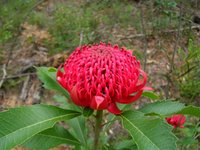 What is this funny looking, red cauliflower thing? It is a Waratah flower-head which has been chewed on by Crimson Rosellas. Click on the photo for a closer look. This is one of the small tragedies of life in the bush, which to my mind, demonstrates that life does not always go according to any great "Plan of Nature".
What is this funny looking, red cauliflower thing? It is a Waratah flower-head which has been chewed on by Crimson Rosellas. Click on the photo for a closer look. This is one of the small tragedies of life in the bush, which to my mind, demonstrates that life does not always go according to any great "Plan of Nature". The New South Wales Waratah (Telopea speciosissima) despite appearances, actually has small red tubular flowers. They are grouped into a rounded head, which is what is commonly thought of as "a Waratah flower". Each tubular flower, as it matures, opens, allowing pollinating agents access to a rich bead of nectar at the base of the tube. Typically, a Honeyeater, such as an Eastern Spinebill, with its long thin beak, will go to the flower, to get the nectar, and in so doing will receive a dusting of pollen on its forehead. Then if it goes to another flower, it might transfer that pollen, to complete the cycle of pollination. Then the flower can develop seeds, to keep the species going.
In this case Crimson Rosellas, which also like Waratah nectar, have used their short, strong beaks to get the nectar by chewing through the base of the flower, and discarding the ruined floral tube. This by-passes the plant's pollination cycle, and destroys any chance of seed setting. In fact, over the next week this flower was almost completely stripped bare; as the new flowers ripened they were chewed off. No seeds from this Waratah next year! Such is life!
 This is the same Waratah flower, just as it reached maturity. A perfect flower. Such flowers are common around Robertson, flowering during October and early November. They may be spotted from the roads around East Kangaloon, and at Carrington Falls, Belmore Falls and Fitzroy Falls Visitors' Centre. They grow as
This is the same Waratah flower, just as it reached maturity. A perfect flower. Such flowers are common around Robertson, flowering during October and early November. They may be spotted from the roads around East Kangaloon, and at Carrington Falls, Belmore Falls and Fitzroy Falls Visitors' Centre. They grow as understory plants beneath the tall Eucalypt forest. Of course, such flowers are protected, and must not be picked, but they may be enjoyed in the bush.
Waratahs grow very well in Robertson and many have been planted in private gardens, and around the historic Railway Station in Robertson. Although in nature, they are restricted to sandstone based soils, they actually do very well on the rich red basalt soils for which Robertson is famous.

1 comment:
I think this blog is pretty cool. But if anything you could always addd the type of beaks and what they do (adaptations) and list a few birds that have that. Example:
Eagle, Hook shaped beak for tearing strips of meat
-Eagle
-Hawk
And on.
Post a Comment